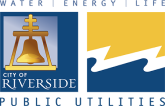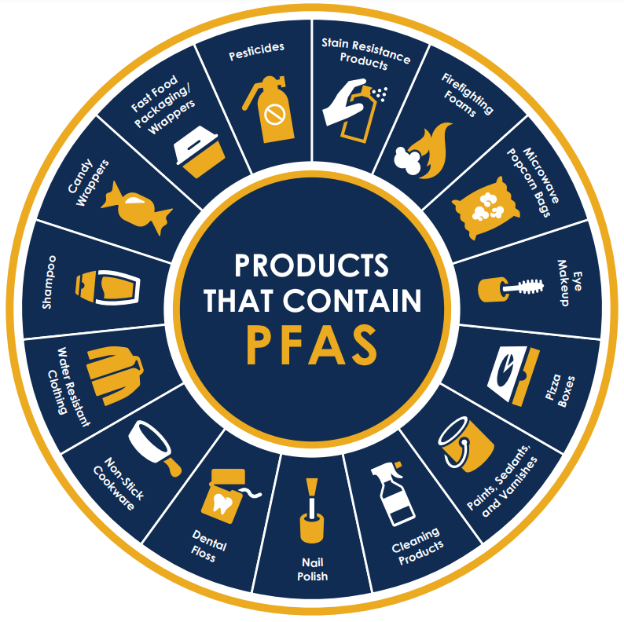Understanding PFAS
On March 15, 2019 the State Water Resources Control Board (SWRCB) ordered water agencies throughout California to test for a group of chemicals known as PFAS over the course of four quarters (12 months) in drinking water wells.
What are PFAS?
PFAS, short for per- and polyfluoroalkyl substances, are a large group of manufactured substances that do not occur naturally in the environment and are resistant to heat, water, and oil. PFAS have been used in a range of industrial and everyday consumer products, such as surface coating for carpeting and upholstery, food paper wrappings, nonstick cookware and fire-fighting foams. Due to the fact that PFAS have been widely used since the 1940s, and that they are nearly indestructible, PFAS have been found both in the environment and in blood samples of people tested.
These substances are persistent in the environment, can accumulate within the human body over time, and are toxic at relatively low concentrations.
Specifically, Perfluorooctane sulfonic acid (PFOS) and perfluorooctanoic acid (PFOA), two types of the PFAS group, are no longer manufactured or imported into the United States; however, there could be some imported goods containing trace amounts of these substances remaining in the U.S.
Exposure to unsafe levels of PFOA/PFOS may result in adverse health effects including developmental effects to fetuses during pregnancy, cancer, liver effects, immune effects, thyroid effects, and other effects (such as cholesterol changes).
How does PFAS get into drinking water?
The four major sources of PFAS are: fire foams used in fire training/fire response sites, industrial and manufacturing sites, landfills, and wastewater treatment plants. PFAS can get into drinking water when products containing them are used or spilled onto the ground or into lakes and rivers. Once in groundwater, PFAS can easily travel long distances and can contaminate the soil and drinking water. PFAS can also be released in the air, which can also end up in rivers and lakes used for drinking water.
What are Notification & Response Levels, and Public Health Goal?
Notification Level - A level of a contaminant in drinking water delivered for human consumption that the Division of Drinking Water (DDW) has determined, based on available scientific information, does not pose a significant health risk but warrants notification pursuant to the California Health & Safety Code section 116455. Notification Levels are non-regulatory, health-based advisory levels established by DDW when there is no maximum contaminant level (MCL) established.
Response Level - A concentration of a contaminant in drinking water delivered for human consumption that DDW recommends that additional steps, beyond a Notification Level be taken to reduce exposure to the contaminant. Response Levels are non-regulatory, health-based advisory levels established by DDW when there is no MCL. The Response Level for PFOA and PFOS combined is currently 70 ppt.
Public Health Goal - A public health goal (PHG) is a level of a contaminant in drinking water that does not pose a significant health risk. A PHG reflects the risk from long-term exposure to a contaminant and should not be used to estimate risks from short-term or acute exposure. Developed by the Office of Environmental Health Hazard Assessment (OEHHA), PHGs are not regulatory requirements, but instead represent non-mandatory goals.
Maximum Contaminant Level
Maximum contaminant level (MCL) is a health protective drinking water standard to be met by public water systems. MCL take into account the chemical's health risks, ability for detectability and treatability, as well as costs of treatment. Health & Safety Code §116365(a) requires a contaminant's MCL to be established at a level as close to its PHG as is technologically and economically feasible, placing primary emphasis on the protection of public health. The MCL is the regulated and enforceable level that water supplier must not exceed.
PFAS New Notification Levels
On August 23, 2019 the SWRCB announced it is lowering the notification levels for PFAS. As shown in Table 1, the new notification levels are provided below. The response level of 70 parts per trillion (ppt) combined PFAS remains unchanged. A ppt is the equivalent of four grains of sugar dissolved in an Olympic-sized swimming pool.
Table 1. State of California PFOS/PFOA Limits
|
|
Constituent |
PFOA |
PFOS |
|
Notification Level |
July 2018 |
14 ppt |
13 ppt |
|
August 2019 |
5.1 ppt |
6.5 ppt |
|
|
Response Level |
July 2018 |
70 ppt combined |
|
|
August 2019 |
No Change |
||
Should I be concerned about RPU’s water?
RPU has not detected PFAS above the notification levels in water distributed to its customers. RPU will continue to monitor for PFAS, and will report the data to the public in the annual Water Quality Report that will be published at the end of the fiscal year on www.RiversidePublicUtilities.com/WQR.
RPU, along with other water and wastewater agencies in California, requested the SWRCB conduct the formal process to establish a Public Health Goal for PFAS. RPU management and staff will remain engaged during this process.
More information on PFAS
More information on PFAS is available from The California State Water Resources Control Board (SWRCB): http://www.waterboards.ca.gov/pfas/ and the U.S. Environmental Protection Agency (EPA): www.epa.gov/pfas/. For additional questions, contact RPU water system representatives at (951) 351-6370 or our Customer Call Center at (951) 826-5311.

